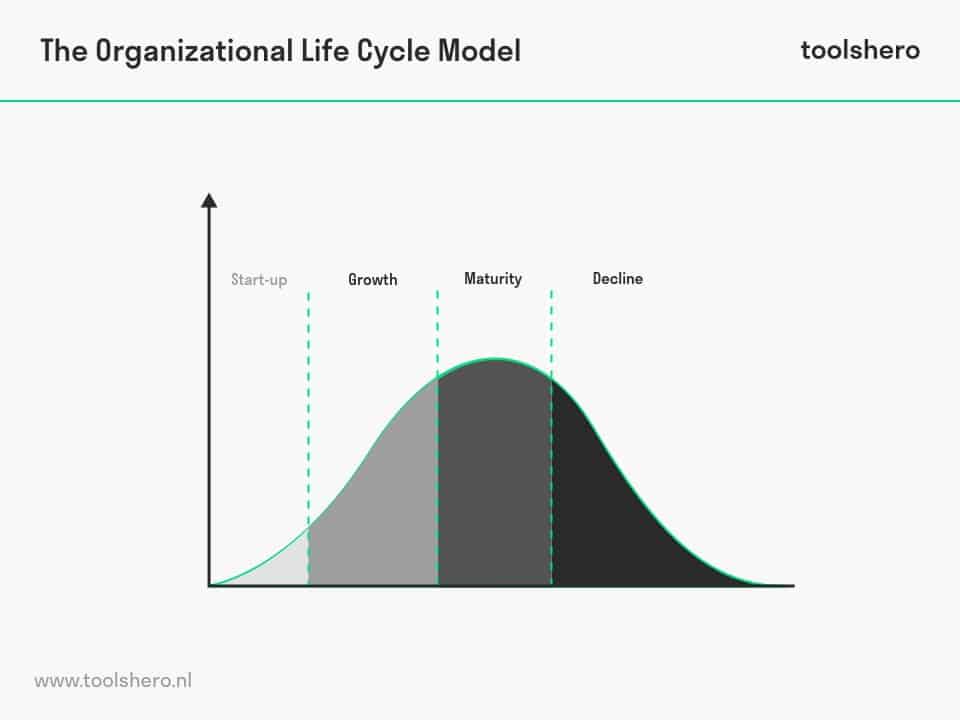Organizational Life Cycle (Adizes)

Organizational Life Cycle: in this article you will find a practical explanation of the Organizational Life Cycle theory by Ichak Adizes. After reading this, you will know the basic concepts of this powerful tool.
Ichak Adizes’s Organizational Life Cycle theory is a cycle of organizational models, which helps managers understand and predict the challenges an organization could face throughout its life.
As indicated, the idea of the organization’s life cycle was developed by business consultant and former professor Ichak Adizes. He says that organizations go through five stages of development: birth, growth, maturity, decline, and death. Each stage lasts for a certain amount of time before moving on to the next stage.
This article aims to provide an introduction to the Organizational Life Cycle model and provide some insights into how managers can deal with these challenges.
This article covers the following topics:
- What is the Organizational Life Cycle?
- Organizational Life Cycle model
- The 4 stages of Organizational Life Cycle
- Organizational Life Cycle theory
- Organizational Life Cycle of Apple
What is the Organizational Life Cycle?
The Organizational Life Cycle Model is a process model which identifies how organizations grow, mature and decline over time. The growth phase of an organization begins as it establishes a foothold in a market and develops its product or service offering.
As the business becomes established within its operating environment, competition intensifies, leading to maturity as the firm strives to continue achieving higher levels of efficiency through cost minimization and quality control. In this stage, some firms may seek opportunities for diversification into new products or services with the aim of augmenting their current revenue stream or creating a new one entirely.
Over time, markets can become saturated so that further growth becomes more difficult, even posing the risk of entering a period of decline where there are no foreseeable prospects for improving market share. This may lead to organizations advocating for new growth strategies even if the time is not yet right, perhaps leading to diversification into emerging markets or the development of new products before they are actually needed.
Organizational Life Cycle model
The Organizational Life Cycle model proposes that there are four phases in an organization’s existence: birth, growth, maturity, and decline. Each phase is characterized by specific factors which influence organizational performance at the time, helping develop appropriate strategies for dealing with each situation effectively. The phases will be considered below in more detail, including management challenges faced during each stage and suggested strategies for moving forward.
The 4 stages of Organizational Life Cycle
The Organizational Life Cycle is the theoretical pattern of phases that are typically followed by an organization.
The Organizational Life Cycle consists of four phases: planning, growth, maturity, and decline. Each phase in the Organizational life cycle is characterized by specific activities and problems.
Start-up / planning
Planning for an organization means determining what type of activity it will engage in and how it will grow.
Growth
Growth generally represents the period when an organization becomes more stable and increases its size and number of employees.
Maturity
Maturity includes a stable workforce with good working relationships among employees.
Decline
Decline is characterized by an aging workforce, fewer customers, and shrinking profits or losses.
Organizational Life Cycle theory
The theory was created by Ichak Adizes in his book titled “Corporate Lifecycles: The Role and Interaction of Management and Markets,” and it has been adopted by many organizations to help them plan for their future.
Ichak Adizes was born in Israel in 1936 and earned his bachelor’s degree from Tel Aviv University before moving to America for his MBA at UCLA. After graduating he became one of the founding partners at Horwitz, Adizes & Company Inc., a consulting company for business management issues.
The concept of Organizational Life Cycle Model was developed based on three main assumptions:
- all systems exist within a larger environment;
- all systems have a boundary that separates them from their environment;
- all systems must take in materials from their environment to maintain themselves.
By taking the concept of an open system as a starting point, a model can be created to track relationships between functions within any given organization.
His model allows for changes that occur during each phase of an organization’s life cycle by describing the major factors that influence organizational performance at the time. In addition, it helps develop appropriate strategies for dealing with those situations effectively.
Applying the Organizational Life Cycle model
There are five main stages of the Organizational Life Cycle model which need to be identified before implementation can begin:
- The “what” stage – where decisions are made about what type of activity an organization will engage in and how it will grow;
- The “where” stage – where decisions are made on where to locate resources or facilities e.g. offices, warehouses etc.;
- The “how” stage – where you make decisions about how to use new capacity, like a building or factory, which could be done by using departments or outsourcing;
- The “situation” stage – where decisions are made on how to fill new organizational capacity created e.g. what roles will be performed by individuals employed in the organization;
- The “control” stage – where managers ensure that controls are implemented so that the objectives set out in the first ‘what’ stage are achieved during all of the remaining stages of planning, growth, maturity and decline.
Key challenges in the planning phase
- Choosing between diversification and market penetration strategies that can affect long-term financial performance – more commonly known as a portfolio choice.
- Determining whether to outsource non-core services.
- Determining how many resources and staff are required to fulfill the organization’s objectives (include key positions).
- How to best attract new customers and market share.
Key challenges in the growth phase
- High costs due to the need to achieve economies of scale e.g. employing more sales representatives or increasing production capacity.
- Dealing with increased competitiveness, especially if the business has expanded into a markedly different type of industry.
- Organization may go through periods of rapid expansion requiring greater investment in order to sustain success which could increase its gearing ratio beyond manageable levels.
- A drive for greater efficiency requires more effective control systems to manage the increase in organizational complexity.
- It may become increasingly difficult to maintain standards of customer service.
- Control of key resources may pose particular problems, especially if they are distant from the organization’s head office.
- Control structures become more complex as organizations grow. For example, managers dealing with branch offices find it far more difficult to monitor activities.
- The need for strategic alliances can present additional management challenges by increasing levels of interdependence between organizations, which could be problematic if proper controls are not put into place.
Key challenges maturity phase
- Stagnant growth rates due to saturated markets making it difficult to achieve economies of scale, so it becomes necessary to seek new ways to expand the business.
- Resistance from managers toward any change in strategy despite lower growth rates due to disinterest with the current strategy and/or realization that there are no better alternatives.
- Some industries will experience saturation resulting in lower profitability, making it difficult for management to justify further investment without evidence of good returns on capital.
- Competition can force organizations into a price war or excessive discounting, which could lead to a temporary increase in market share but at a cost that may undermine long-term profitability.
- Differentiation strategies become less effective as customers purchase products based on the lowest price, while brand loyalty decreases.
- Profitability tends to decline as organizations mature and face greater price pressure from competitors.
Key challenges decline phase
- The need to diversify into new markets, products, or activities as growth slows down.
- Problems arise due to a lack of demand for current products or services, where excess capacity needs to be managed.
- Outdated technology becomes problematic, resulting in loss of market share.
- Increased trade union activity: Any industry where union influence is strong may suffer unrest and strike action if demands are not met, resulting in cost implications and production disruption with an impact on profitability. If this results in legal disputes and compensation charges, it can involve significant costs.
- With lower levels of profitability, organizations risk becoming takeover targets.
Strategies in different phases
Growth
Organizations need to widen their geographical spread to bring access to new markets and customers, as well as extend the range of products or services offered. There may also be a need for diversification into related activities to complement the existing business.
Maturity
This is a crucial time for management as they will need to develop a strategy that manages decline effectively while at the same time ensuring that resources are not wasted on expanding into loss-making areas of the business too early.
Decline
It is important that once an organization recognizes that demand has reduced, then no further funds should be invested in development; instead, management should seek ways to withdraw from certain activities if this is economically viable.
Organizational Life Cycle of Apple
Apple as a practical example of the Organizational Life Cycle
Apple is a company with a long and interesting history. They have gone through many changes in the past few decades, and some of those changes can be examples of the Organizational Life Cycle.
The first stage of the Apple’s Organizational Life Cycle was an entrepreneurial start-up. Steve Jobs and Steve Wozniak were focused on creating new technology and on advancing the state of computers.
They were successful in doing so, but their success came at a price: they had to sacrifice other things like employee salaries and customer service. This is all because they chose to focus on the new technology aspect of Apple rather than on customer satisfaction or financial stability
The second stage comes after Apple became publicly traded for ten years under Jobs’s leadership. At this point, Apple was more focused on the customer’s experience and their products were more profitable. This second stage was a great success for Apple, but it wasn’t all sunshine and rainbows: Jobs became increasingly focused on creating better technology rather than focusing on customers, which led to his departure from Apple in 1985.
The third Organizational Life Cycle of Apple is what we see today. Tim Cook has taken over as CEO since then, and he focuses much more heavily on marketing/branding while remaining committed to technological innovation. He’s also been successful with this Organizational Life Cycle because they have created two new product categories under his leadership (iPad & Smartwatch). However, there are some challenges that come with being one of the biggest companies in the world: Apple is now facing issues with profitability, and it’s becoming more difficult for them to innovate in a way that feels fresh.
This Organizational Life Cycle of Apple can be seen as a microcosm of what happens within most companies when they go from entrepreneurial start-ups to publicly traded corporations, and finally towards being one of the biggest brands in the world. The only difference is that there are usually at least 20 years between each Organizational Life Cycle phase, whereas Apple has experienced all three phases in just 40 years’ time.
Some important highlights to understand the Organizational Life Cycle
The Organizational Life Cycle is the general pattern of phases that are typically followed by an organization.
The four main phases of the cycle are planning, growth, maturity, and decline, which take place in sequence with each other. Each phase has its own unique characteristics associated with it, which managers need to understand if they are to lead their organizations successfully through the cycle.
The length of time for each phase may vary according to several factors, such as resource constraints or external forces that inhibit movement between stages. For example, the organizational decline can be hastened when there is insufficient cash flow to fund projects or an increase in taxation rates will reduce profit margins while demand for products decreases due to downturns reducing sales revenue, etc.
The Organizational Life Cycle Theory is more applicable to non-profit, public, or voluntary organizations than for-profit firms. For example, the decline stage in a firm’s life cycle often means that it can no longer generate enough profits to cover costs and therefore has to declare insolvency and close down. In contrast, charities do not need to be profitable and can continue with limited resources if they have a sufficiently large donor base who give regularly for this purpose.
Organizational Size: As one would expect from any model of organizational development, size matters when it comes to the adoption of the Adizes’ theory. The Organizational Life Cycle model is only applicable in larger organizations, as its effectiveness diminishes in small to medium-sized firms.
The Organizational Life Cycle model is very effective for strategic planning, especially in the organizational growth and maturity phases, when managers are more able to look at long-term development issues.
Now it’s your turn
What do you think? Do you understand the explanation of positivism? If you have any questions or want to provide feedback about this article, don’t hesitate to leave a comment below. We would love to hear from you!
More information
- Adizes, I. (2004). Managing corporate lifecycles. The adizes institute publishing.
- Givhan, R. N. (2014). Aligning Corporate Lifecycles and Product Lifecycles. AuthorHouse.
- Adizes, I. (1979). Organizational passages—diagnosing and treating lifecycle problems of organizations. Organizational dynamics, 8(1), 3-25.
How to cite this article:
Ospina Avendano, D. (2021). Organizational Life Cycle (Adizes). Retrieved [insert date] from Toolshero: https://www.toolshero.com/strategy/organizational-life-cycle-adizes/
Add a link to this page on your website:
<a href=”https://www.toolshero.com/strategy/organizational-life-cycle-adizes/”>Toolshero: Organizational Life Cycle (Adizes)</a>













